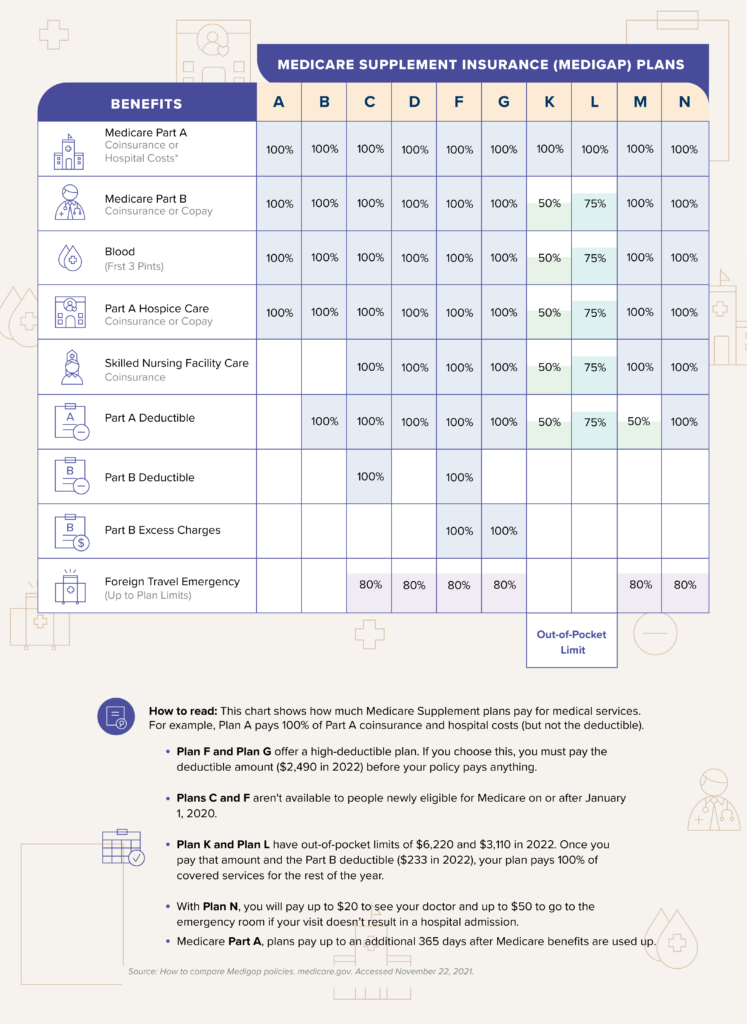Original Medicare – which is Medicare Part A and Part B combined – covers many of your healthcare expenses, but you’ll still be responsible for costs like copayments and deductibles.1 Those expenses can quickly add up if you have frequent healthcare needs.
A Medigap policy, also called a Medicare Supplement plan, provides extra coverage to help cover those healthcare costs. Your Original Medicare pays its contribution toward your expenses, then your Medigap policy contributes to the remaining fees. With a Medigap policy, you may be able to reduce or even eliminate what you pay out of pocket.
What You Need to Know
Original Medicare covers many healthcare expenses, but you’ll still be responsible for some costs like copayments and deductibles. A Medigap policy can help to cover those out-of-pocket fees.
To qualify for a Medigap policy, you’ll need to be enrolled in Medicare Parts A and B.
In Ohio, you can choose from 10 Medigap policies, each offering slightly different coverage. Two plans are available with high-deductible options.
When Can You Enroll in Medigap?
Like traditional health insurance, Medigap has an Open Enrollment Period, and it’s easiest to enroll during that time. Your Open Enrollment Period automatically begins the month you turn 65 and are enrolled in Medicare Part B.2 During this period, you can buy any Medigap policy available in Ohio, even if you have a preexisting health condition like diabetes.
After your Open Enrollment Period ends, you can still buy a policy, but it becomes more complicated. After this period, insurance companies can deny you coverage if you have a preexisting condition. Insurance companies can also exclude your preexisting condition or require a six-month waiting period before your coverage begins.
However, with guaranteed issue rights, you can change or enroll in a Medigap policy outside of open enrollment without being subject to these restrictions.3 When you have guaranteed issue rights, an insurance company must let you buy a policy. You also can’t be denied coverage for a preexisting condition, and your policy cost can’t be increased. To qualify for guaranteed issue rights, you’ll need to experience a specific event, like moving outside of your Medicare Advantage plan’s service area.
Certain events, like losing your current insurance, might qualify you for what’s called a Special Enrollment Period.4 During this period, you can make changes to your coverage. The types of changes that you can make will depend on the type of qualifying event that you’ve experienced.
Did You Know?
Outside of your Open Enrollment Period, it can be difficult to select or change your Medigap policy – unless you go through certain changes, such as moving to a new area.
Outside of your Open Enrollment Period, it can be difficult to select or change your Medigap policy – unless you go through certain changes, such as moving to a new area.
What Are the Most Popular Medicare Supplement Plans?
| Plan Type | Total Enrolled (Rounded) | Percent of Total Enrolled |
| Plan F | 252,000 | 41% |
| Plan G | 184,000 | 30% |
| Plan N | 98,000 | 16% |
You can choose from 10 Medigap plans in Ohio.5 Plan F and Plan G also feature high-deductible options. Coverage varies between plans, but Plans F, G, and N tend to be the most popular. It’s important to review the coverage each plan offers to choose the one that’s best for you. Note: Plan F is not available if you are eligible for Medicare after January 1, 2020.
Plan F
Plan F offers the most comprehensive coverage. It includes:
- Part A coinsurance and hospital costs
- Part B copays/coinsurance
- Blood (first 3 pints)
- Part A hospice
- Skilled nursing facility
- Part A deductible
- Part B deductible
- Part B excess charges
- Foreign travel emergency – 80%
Plan G
Plan G is similar to Plan F, but it excludes the Part B deductible:
- Part A coinsurance and hospital costs
- Part B copays/coinsurance
- Blood (first 3 pints)
- Part A hospice
- Skilled nursing facility
- Part A deductible
- Part B excess charges
- Foreign travel emergency – 80%
Plan N
Plan N offers almost the same coverage as Plan F, excluding the Part B deductible and Part B excess charges:
- Part A coinsurance and hospital costs
- Part B copays/coinsurance
- Blood (first 3 pints)
- Part A hospice
- Skilled nursing facility
- Part A deductible
- Foreign travel emergency – 80%
You can easily compare Medigap policies with MedicareGuide.com.
How to Choose a Medicare Supplement Plan
Because each plan offers slightly different coverage, it’s important to consider the types of healthcare expenses that you have most often. Look for a plan that covers those costs with a premium that you can reasonably afford. A third-party comparison tool like MedicareGuide.com can help you to easily compare different policies.
How Much Do Medigap Policies Cost?
The coverage and cost of Medigap plans varies. The following prices reflect a quote for a 65-year-old female and male nonsmoker in Ohio. They can give you a rough idea of Medigap plan costs.
65-Year-Old Woman, No Tobacco Use
| Plan Type | Premium Range |
| Plan F | $116-$382 |
| Plan G | $92-$361 |
| Plan N | $73-$341 |
65-Year-Old Man, No Tobacco Use
| Plan Type | Premium Range |
| Plan F | $131-$432 |
| Plan G | $104-$408 |
| Plan N | $83-$385 |
What Companies Sell Medigap in Ohio?
A Word of Advice
What you pay for Medigap coverage can vary widely. Remember that if you choose a high-deductible plan, you’ll pay less for your monthly premium, but potentially much more in deductibles once you use services.
What you pay for Medigap coverage can vary widely. Remember that if you choose a high-deductible plan, you’ll pay less for your monthly premium, but potentially much more in deductibles once you use services.
What If You Want to Change Your Medigap Policy?
While you can change your policy during your Open Enrollment Period, guaranteed issue rights, or Special Enrollment Period, you won’t have many other opportunities to choose a different plan. This means it’s important to thoroughly research all of the policies to pick the one that works best for your needs so you don’t have to try to change it later.
What Are Alternatives to Medicare Supplement?
Like Medigap policies, Medicare Advantage plans help to cover some of the costs that you’re responsible for with Medicare Part A and Part B.6 Some Medicare Advantage plans even offer prescription coverage, which Medigap doesn’t offer.
What Are Medicare Resources in Ohio?
- The Ohio Senior Health Insurance Information Program offers multiple resources to help you learn about Medicare and sign up for a plan. Resources include Medicare webinars, one-on-one counseling, and more.
- The Ohio Department of Insurance offers free health insurance information and education to help you learn about the insurance options available to you.
- The Ohio Department of Medicaid offers information about available Medicaid plans, and can also help to answer questions about your Medicaid coverage.
Snippet Render Is Present – D3 cannot be loaded in editor mode. Go to preview or publish mode.

Next Steps/Conclusion
Medicare covers many of your healthcare costs, but out-of-pocket expenses like deductibles can still quickly add up. A Medigap policy can help to reduce or even eliminate the fees that you’re responsible for. To learn more, check out How to Choose a Medicare Supplement Plan.


